Hostage Rescue in the Home

“Wait,” you say. “I’m not on a SWAT team. When would I ever do hostage rescue?“
You might need hostage rescue skills before the next sunrise. Consider the following definitions.
The difference between a burglary and a home invasion is this:
A burglar hopes you’re not home. Smart burglars case the joint (conduct pre-op surveillance) to be sure.
A home invader knows you ARE home, and wants you there.
Think about that.
If you live alone, or share a bedroom with the only other people in the house, and you hear someone breaking in, that is NOT the time to leave the bedroom and go hunting. Lock your bedroom door and call the cops. If you have access to a firearm, point it at the door and wait.
If you are unarmed, arm yourself with something, even if it’s only a golf club.
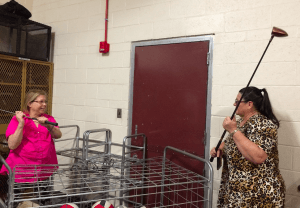
Consider escape, but also consider this: you know what’s going on in that room. You do NOT know what’s going on outside. A common TTP (tactic / technique / procedure) used by multiple assailants is to send somebody in while others wait outside to ambush any squirters (those who flee from the building).
Some reading this have children (or grandchildren). If not, one day, you could conceivably have kids. It might be sad if you don’t–the pie slicers are rapidly outbreeding the pie makers, and somebody has to be raised to take care of the next generation. If you don’t, maybe you’ll be babysitting a third cousin or whatever. Let’s say you wake to hear screams and adult-voiced curses from the kid’s room. Are you going to dial 911, hide behind your bed, and wait for the cops to arrive? Or are you going on an immediate rescue mission?
If you would choose the latter, it helps to have some useable, appropriate skills.
Hostage Rescue 101: No Quarter
In Heloderm classes, we talk about a criminal’s instrumental, as opposed to intentional, use of weapons.
INTENTIONAL use of a weapon means they came there to murder somebody.
INSTRUMENTAL use means they are using the weapon and / or threatening the hostage as an instrument of power projection, to get you to do something you would not otherwise do.
While a hostage taker’s use of the weapon and the accompanying human shield is instrumental, it can become intentional any second, which is why we show hostage takers no mercy.
There’s nothing wrong with talking, although it accesses a different part of your brain than the fighting part. If a bad guy wants YOU to talk, he’s probably setting you up for a fall. If you can convince him to drop the knife and leave, good for you. But the longer the situation goes on and the more desperate he becomes, the greater the chances that he will harm the hostage. In small unit tactics, we frequently talk about “time, distance, and shielding.” You want to minimize the time that knife is by your little boy’s throat.
I know, when police departments encounter a “barricaded suspect” with hostages, they have historically preferred to take their time, to starve him out and bore him to death with talk. But police departments have SWAT teams and snipers if things suddenly go south. When Jane Q Public is talking with the guy who’s not wearing a mask and is threatening to kill her entire family, Jane’s attempts to “negotiate” are probably only to keep the bad guy’s mind off of murder long enough for Jane to get close enough to neutralize him.

If you think “no mercy” is a bit harsh, you are living in the past. This is no longer the era of Dog Day Afternoon and Stockholm Syndrome. Hostage takers used to be desperate desperados in robberies gone bad (actually gone good, in that the cops got there before they got away). Modern hostage taker terrorists are only delaying the execution of the hostages till the cameras are on-scene and rolling.
Home Invasion 101
It needn’t be an international plot funded by Hamas. It could simply be an American psycho.
[Home] “Intruders are terrorists without a political agenda–they want to confront you, control you, injure you.”
–Sanford Strong, former San Diego PD SWAT, Strong on Defense, p. 170
Depending on whose numbers you believe, you are three to six times as likely to be killed or seriously injured during a home invasion than you are if you are accosted with criminal intent outside the home.
That’s the bad news. The good news, if any, about home invasions is that most of them are conducted by “rip crews” stealing the drugs and cash of a rival drug dealer. If you don’t have dope stacked floor to ceiling in your house, including the kid’s closets (yes, I’ve seen that), and you don’t advertise that you have guns, jewelry or cash on hand, your chances of being targeted for burglary or home invasion are less.
While we’re on the subject, home invaders get in via one of three means:
- Unlocked doors or windows
- Forced entry (breaking in)
- A ruse (“Candygram for Mongo”)
Open doors
Lock your danged doors. Until near the end of his three-year terror spree, Tucson’s “Prime Time rapist” (see below) ALWAYS came in through an unlocked door or window. The killer at Robb Elementary (see Uvalde below) waltzed in through unlocked doors.

When the Parker families moved to the Texas frontier, the built a very stout stockade, with towers on opposite corners. The towers stuck out from the walls, giving them enfilade down each wall. They had loopholes from which to shoot attackers off the walls.
The entrance was inside an entrapment area (just to the right of the lower tower in this photo) inside which attackers attempting to breach the gate could be shot from several directions–similar in function to the entrance of the West Ruins in Aztec, New Mexico, and a modern-day nuclear weapons storage area. Building that fort wound up being wasted effort. THEY HAD LEFT THE GATE OPEN when the Comanche attacked.
As Robbie Risner said about being tortured in a North Vietnamese prison, “Don’t give them anything for free.” Locking the door is not a heavy lift.
Forced Entry
If they are breaking in, the noise of breaking glass or a door being forced should buy you time to implement an emergency action plan. A sample checklist might include:
- Everybody go to the primary safe room,
- Lock the bedroom door,
- Account for everyone
- Call the cops
- Arm up (distribute weapons)
- Don body armor, if any
- Etc.
If the primary safe room or that side of the house IS the entry point, fall back to the alternate safe room. Again, consider escape, but balance that decision against the risks of attempted escape.
If the guy is already in the house, and is threatening one of you to consolidate his control over all of you, that is the time for the kids to escape and run to a trusted neighbor’s place, and / or use their cell phone to call 911.
Ruses
In another historical example from the European American colonization of the Native American plains, almost all of the families killed in the so-called “Spirit Lake Massacre” let members of Inkpaduta’s band into their cabins under the pretext of a parley. They provisioned and even fed their killers before they were set upon (Abbie Gardner-Sharp, History of the Spirit Lake Massacre & Captivity of Miss Abbie Gardner: The Raid of the Santee Sioux Against the Iowa Frontier Settlements, 1857).

Similarly, contemporary home invasions often start with some innocent looking way to get you to open the door. Once it’s cracked, they force the rest of their way in.
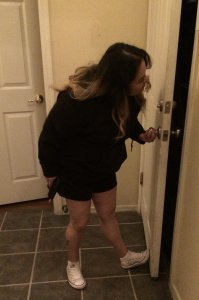
If I ordered DoorDash, and it’s about the time the food should arrive, I’m expecting the doorbell to ring. I answer the door with the cash for the food and empty hands to carry it. If I’m really prepared, I might have a roscoe concealed on my person, but, I must confess, usually not.
If, on the other hand, I’m NOT expecting visitors, I answer the door with a handgun behind my thigh in what we used to call “Car Stop Ready.” I have a security screen door with bars or I probably wouldn’t even crack the inner door. If I didn’t have a security door, and I felt the need to crack the door for communication, I’d have the toes of a foot up against the door, just in case it gets shoved in my face.
If they have delivery, ask them to leave it on the porch. If they insist on a signature, ask them who it’s from. If things don’t add up, tell them you’ve got COVID and you’ll send someone to the UPS / Fed Ex / USPS office later to pick it up. If that doesn’t make them leave, ask yourself why.

The fact that you are not expecting company does NOT give you carte blanche to shoot an unarmed person–even one who is beating on the door and screaming–off of your porch through the locked door. But if you answer the door and get knocked down when it’s shoved in your face, followed by three hoodlums with tire irons trampling you, it will be too late to run and get your gun out of the safe.
If you do not have any narcotics to steal, the home invader comes into your house to terrorize, rape, kidnap, ravage, murder. I repeat, if they just wanted to steal some jewelry, coins, and electronics, they’d have waited till you were gone.
Case Study: the Prime Time Rapist
From April of 1983 till September of 1986, Tucson’s “Prime Time Rapist” invaded homes during what was known, in those days before content streaming, as “prime time” television viewing hours (just after dinner). He tied up husbands and raped mothers, daughters, and wives in front of their families. His victims ranged in age from five years old–five!–to elderly, 90 people in 30 incidents.
Home Invasion 102: Freedom is Indeed Worth Fighting For
Suppose a home invader holds a knife to your husband’s throat, and says “I’m not here to hurt anybody. I just need to tie you up so nobody gets hurt.”
You will want desperately, so desperately, to believe him.
Do not.
HE IS LYING.
He wants to tie you all up–to restrict your freedom of movement, your freedom of action–so HE doesn’t get hurt, while he rapes you and your daughter in front of the family, and maims or kills your husband in front of you.
I’ll say it again: if all he wanted was your stuff, he would’ve waited till you were out of the house.
Case Study: A San Francisco Home Invasion

On 19 Apr 1974, a man broke into Frank and Annette Carlson’s home. They were both young, in their twenties. They never resisted in any way. He threatened Annette with a knife and used electrical cord to tie Frank to a chair.
He broke a jar of coins over Frank’s head. He asked Annette for a hammer, which she provided. He used the hammer on Frank’s head until he broke the shaft. Yes, actually broke the handle, he hit Franks’ skull so hard. He also broke a ceramic plant pot or vase (with soil and plant) over Franks’ head, and broke a cutting board over Frank’s head.
After telling Annette he could not let her live because he had murdered her husband and she had seen his face, he took Annette upstairs and raped her for 3 hours in every possible way. She spent the time begging to be allowed to live. Then he broke a rocking chair over her and beat her head repeatedly with a paper weight in a towel. She endured all that so he would not use the knife on her. Finally, even though she had cooperated in every way, he did: he slashed her wrists.
Main takeaway: If you don’t do what an assailant with a knife says, you might get cut. If you DO do what the assailant with the knife says, you might get cut.
He doused the house of the Carlsons with paint thinner and kerosene, and set them on fire before departing. She crawled out a window and screamed for help from her rooftop. Frank was already dead, but Annette, miraculously, lived. The doctors actually let SF Homicide Inspectors Frank Falzon and Jack Cleary question her during surgery, because they did not expect her to live.
The killer was caught and sentenced to death in 1976, but in ’78 the California Supreme Court determined that capital punishment is cruel and unusual. The murderer got married in prison, and fathered two children (Strong, pp. 172 – 77). He’s been parole eligible since 1980, so Annette has had to go to the parole hearings and relive the events 18 times to keep him behind bars (visit justiceforfrank.org if you want to help). It makes me sick relaying these details to you, but like Sanford Strong, I cannot emphasize enough that your freedom of movement and action should never be given up. Did I mention this? NEVER LET THEM TIE YOU UP.
Incidentally, he told Annette he was on cocaine, as was a young man who murdered two of my friends (and killed two others and wounded two more). But, as every Oregon voter knows, doing drugs is a victimless crime. Getting back to the main point here, it bears repeating that:
Anytime anyone wants to tie you up or put you in a trunk or otherwise restrict your freedom to leave or to act, FIGHT THEM RIGHT HERE, RIGHT NOW, while you still have some freedom of movement and action. After you’re tied up or out in the middle of the desert is not the time to start fighting back. By then it will probably be too late. No one will be around to hear you scream.

Invaders tell older kids, especially males, to stay in corners or closets, or to lie down on the floor, as far away from the invader as possible, while they tie up dad. DO NOT ASSIST IN YOUR OWN FAMILY’S TORTURE AND EXECUTION.
Any study of the atrocity list of recent years–Starkweather, Speck, Manson, Richard Hickok, and Cary Smith, et al–shows immediately that the victims, by their appalling ineptitude and timidity, virtually assisted in their own murders. (“Don’t make them mad, Martha, so they won’t hurt us.”)
–Col “Jeff” Cooper, Principles of Personal Defense
If we could only ask them, I’m fairly certain that six million Jews murdered by the Nazis in the 1930s and 1940s would tell us that, if they had it to do over again, they would not have gone quietly. Many did resist, and many of those–perhaps most–were killed for their efforts. But at least they died with dignity, on their feet instead of gasping for air in a gas chamber, and may even have taken a few Nazis with them. Your chances against one guy with a knife or even a gun are probably much, much better than those the brave, under-armed partisans of the Warsaw Ghetto uprising had against MG42 machine guns and 88mm artillery.
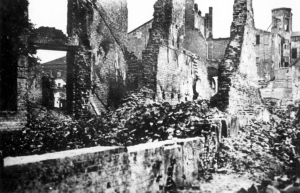
Unarmed Against the Home Invader Hostage Taker
If you are unarmed, get and stay close to the hostage, no matter what the hostage taker tells you. Tell the invader that if he hurts anyone in your family, you will have nothing to lose and a very sympathetic jury.
Suppose he says, “I’m leaving here with this baby. If you try to stop me I’ll carve her up,” is there any planet in this galaxy where you’re going to let him leave with your baby? Maybe he just wants the kid as insurance till he can get to the car. Maybe he wants to stick little Timmy in the microwave and eat him for dinner. Probably not, but only probably. The only thing we know for sure is, if he gave a damn about Timmy’s safety, he wouldn’t have a knife to Timmy’s throat. Maybe he’s strung out on dope and not prone to making rational decisions, or driving safely, or even using a knife or gun carefully.
Ask him,”Or what? If I don’t let you leave, whatchu gonna do?”
When he threatens to kill your kid, tell him “You kill him, and there will be nothing alive between me and you. I will fight you with everything I have. You are not leaving here with my baby. If you set him down carefully now, and get out, I will not pursue you. But if you try to take my baby, I WILL KILL YOU.”
The key is to make yourself a threat to his very existence, by closing with him. When he feels threatened enough by you, he will take that knife from your kid’s throat (or that gun from your kid’s head) and point it at you. If you have closed to within arms’ reach, that’s your moment. Off-line it and control it. Yes, it is very doable, if you practice realistically. Anybody who sticks a gun in your face just handed it to you.

If your children are older than toddlers, train them to escape and notify the neighbors and / or escape with their cell phones while you keep the invader busy. Escape is not the first choice if you are armed and can bunker down. But if you are NOT armed, having your kids escape while you keep the intruder busy may be your only viable option.
Everybody yell and scream and cause a ruckus. Unusual attention favors you, not the intruder.
Armed Against the Home Invader Hostage Taker
I cannot emphasize this enough: if you are armed,
Even when he threatens to kill the hostage if you don’t,
NEVER, EVER, GIVE UP YOUR GUN.
THAT ONLY WORKS ON TV.
IF YOU DO, YOU WILL BE SHOT WITH YOUR OWN GUN AND THE HOSTAGE WILL ALMOST CERTAINLY DIE (OR BE RAPED / KIDNAPPED) ANYWAY. Tragic statistics bear this out.
If somebody has a knife to your kid’s throat, the stakes are way too high for you to take any chances. Take the bad guy out as soon as you get a clear shot.
Of course, that depends on you being good enough to make that clear shot. It takes REALISTIC practice, plus a lot of dry practice. You can never start too soon, or practice enough, because in hostage situations, missing is not an option.
Don’t take the shot unless you are CERTAIN you can stop the hostage taker without hitting the hostage. I was the top marksman from my Security Police Academy class, the top marksman from my Border Patrol Academy class, the top rifle shooter from my Combat Arms (military firearms instructor) class, but even at the peak of my abilities (some years ago) I would have been reluctant to take a head shot on a hostage taker unless the hostage taker and hostage were relatively stationary and I had most of his head to shoot at.
It helps if you and your family have worked out a plan if any one of them is taken hostage, ahead of time. For example, “If I say ‘kangaroo,’ go limp so I can have a clearer shot to take him out.”

Getting that, a decent percentage of his head to shoot at, is immensely easier with a partner, IF you both have trained to create such an opportunity with the V to L. More on the V to L in a minute.
Managing the X
Anybody who knows anything about movement in relation to personal protection knows:
- Almost all fights start as ambushes,
- The kill zone of the ambush is called “the X,” and
- One key to our survival is to move explosively OFF the X before anything kinetic connects with us there.
However,
In hostage rescue, your child (or sig-o, or whomever) is pinned to the X.
My friend Jay O talks about “Managing the X.” You will need to maneuver around the X, or get the hostage taker to maneuver around the X, in a favorable way.
How to get a clear shot when real hostage takers move?
If your hostage taker is right handed, you will usually see more of his head to your left. However, if you move to your left to get a clearer shot, he will likely rotate his human shield around between you. This contrasts sharply–perhaps fatally–with the hostage taker targets when we practice on the range. Those are motionless cardboard with no brain and no will to live or to stay out of jail. And still, sometimes, the hostage target gets shot.
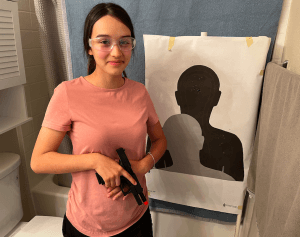
Two dimensional targets are a good place to start, to build confidence that you can hit a head-sized target. But they can build false confidence because, again, real hostage takers move.
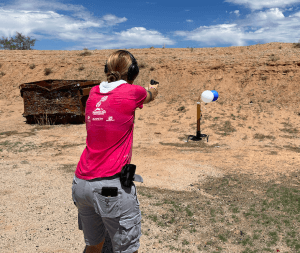
Tying two different colored helium balloons together and having a training partner call out a color is a great way to practice waiting (or moving, if the range / backstop permit) till you have a clear head shot–and then taking it during that limited window of opportunity without hitting the “hostage’s head” balloon.

When the target is moving unpredictably, sometimes behind (or in front of) a “no shoot” like a hostage or bystander, rescuers have a tendency to wait for just the right moment (good) and then snatch the trigger, hard (bad). This can lead to the wrong person getting shot.
One key is to keep your sights on the bad guy’s head, wait for your moment (or move to get a better angle), and then roll steadily through the trigger while keeping your sights on him, even as he moves. If your moment of opportunity goes away before the shot breaks, take your finger off the trigger and start all over again, moving your platform (i.e., yourself) into a better position as necessary.
By “pressuring” the hostage taker in certain ways, we can get HIM to move fairly predictably, opening up a shot.
Get Him in an L
It helps to have a partner.
When we talk about “getting bad guys in an L,” we mean the approximately 90 degree apex of a more or less right triangle.
When you are unarmed and getting shot at, moving away from your partner along separate forward oblique vectors (that look like a V from above) forces the bad guy into a “shooter’s dilemma:” he must pick one or the other of you. He can’t shoot you both at the same time. While that may be tragic for one of you, it may set the other up to take him down. The alternative, just standing there next to each other and staring, perhaps begging for your life, will likely get both of you killed.
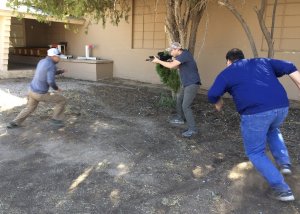
In hostage rescue, the goal of the L is similar, but not identical. Basically, when you have him in an L, he can’t use the hostage (or other forms of cover) as a shield from both of you at the same time.
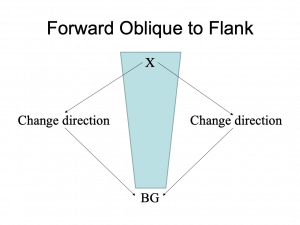
This diagram illustrates the V to L from the bad guy’s perspective. The bad guy starts at BG. The teal blue trapezoid represents his initial cone of fire. The good guys / gals start at X and move along separate forward obliques. Once they have the bad guy in an L, they can stop (ideally, causing the bad guy’s aim to traverse past the one he was catching up with) and return fire, or, if unarmed, they can close with the assailant. If the bad guy has a hostage, he most likely will turn his hostage in the direction of the first Rescuer he sees (read on).
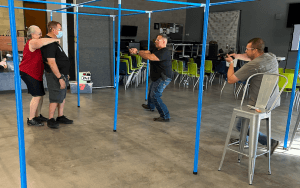
Light Management in Hostage Rescue
If the kidnapping takes place in broad daylight, or the lights in your house are already on, the flashlight technique in this section mostly does not apply. The movement still does, whether it’s bright or dark.
If it happens to be dark when he breaks in, that can act to your advantage, IF you are comfortable working in the dark, and integrating a hand held flashlight with your pistol, or if you have a pistol light.
Darkness usually favors the forces of darkness, but this is one exception. More precisely, keeping the room dark with proper light management can improve your chances of a successful outcome in hostage rescue.
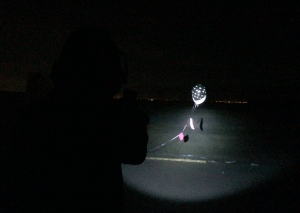
Read on to find out how proper light management, combined with (perhaps counterintuitive) movement toward the the hostages’ side, by the First Rescuer can dramatically improve your chances of a successful outcome. But while flashlights can help, MOVEMENT is the key. We have to discuss movement into the room where the hostage is being held, whether or not it’s dark in there.
First in Goes to the Hostage Side
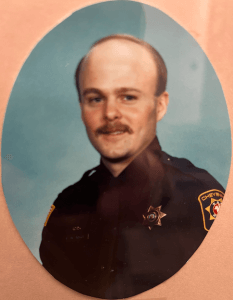
I’ll never forget being dispatched to my first 911 hangup.
“Know what that means?” asked Bob, my FTO (field training officer), as we started rolling our rig in that direction.
“Could be anything,” I replied. “Could be a prank, could be a misdial, could be a homicide in progress.”
“That’s right. Know what else it means?”
“Hmmn?”
“It means you’re going in the door first.”
I’ve been first (and second, and fifth) through many, many doors since that night more than a quarter of a century ago. I hope to share as many of the lessons I learned along the way as I can with you. Here are a few:
5 out of 6 hostage takers (mas o menos) are right handed. They will usually hold their weapon in the dominant hand and the hostage with the other. Number One Rescuer in the door’s job is to OPEN UP A SHOT FOR NUMBER TWO. If it’s dark, put a flashlight in his eyes and MOVE TOWARD THE HOSTAGE’S SIDE.
If you want, you can strobe him. You do NOT need a “strobe” setting on your handheld flashlight to do this. A fast thumb will do the same job of blinding him with a lot more control. In fact, the more settings your flashlight has, the more likely it is to do what you don’t want, when you don’t want it to.
Worst of all is a click-on, click-off switch. Your best bet is a plain white-light flashlight with a pressure switch that turns off like a light-saber when dropped, though those are hard to find these days. If you’re stuck with a flashlight that has a click on / click off feature, using the tip of your thumb, rather than the pad, might keep you from clicking it on by accident. We go into much greater detail about flashlight selection and technique in Heloderm Night Fighting classes.
While we’re on the subject of equipment, handguns are usually better tools for in-home hostage rescue than rifles, and certainly better than shotguns. A handgun is simply easier to maneuver around in tight confines. If you’re close enough, you could even gank the hostage’s head out of the way and shoot him “around the corner” (at a near perpendicular angle to your line of sight) with a handgun, without even being able to see the sights. Just keep in mind that if you stick your gun into his space, within his arms’ reach, he can take it away. See ARs in Hostage Rescue below for long gun specifics.
Getting back to flashlights, while you’re blinding the bad guy, theoretically he’ll turn the hostage toward you (usually to your right, his left). Meanwhile, Number Two through the door is moving stealthily, WITHOUT USING ANY LIGHT, toward the other end of the L. When Number Two gets a clear shot, certain s/he can take it without injuring the hostage, Number Two takes it.
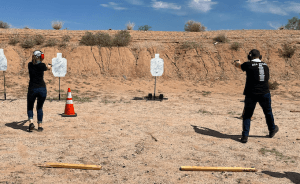
If the hostage taker catches on and suddenly turns his human shield toward Number Two, Number One takes the shot. Whoever gets a clear shot can take it.
How to Practice These Skills
It’s a good idea to practice these skillsets in two phases:
- Human Target Engagement (HTE), and
- Live Fire (including at night / in the dark)
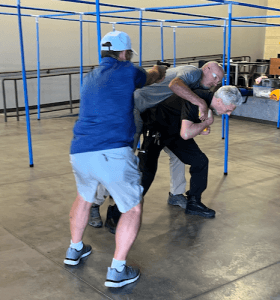
HTE Phase
The first phase, and a critical one (more important toward understanding and mastering this skillset than live fire), is HTE (human target engagement; i.e., role playing) walk-throughs with “finger pistols” (bare hands) or plastic inert replica pistols or pistols demilitarized with a barrel insert. You can do this in your own home.
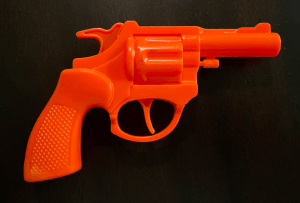
You need four participants to work this drill.
- One plays the Hostage.
- One plays the Hostage Taker. Two others play:
- Rescuer One
- Rescuer Two.
One and Two stack outside the “door.” Number Two can “squeeze up,” giving Number One’s shoulder a gentle whole hand pinch, and / or whisper “You’ve got one.”

1 + 1 = 2, and two is all you need, so Number One goes in.
As Rescuer Number One moves toward the hostage side (lighting the Hostage Taker’s face up like a disco ball with a flashlight, if it’s dark), Hostage Taker cranks Hostage around between them. Number Two moves till s/he has a clear shot and says “Bang!” or some such. Reset the drill, switching roles, and do it again, till everybody had been Rescuers One and Two several times.
Every now and then, have a left handed hostage taker.
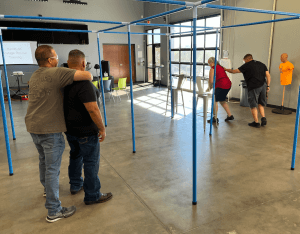
Rescuer One simply goes to whichever side the Hostage is on. Two simply goes whichever way One did NOT go.
In real life you might not be inclined to wait till your spouse or Sig-O or roommate arms up and follows you. If you need to do a solo rescue mission because he’s already dragged your kid halfway out the window, go now. But your chances of a successful outcome are much higher if you have a partner right behind you as you go through the door.
Live Fire Phase
Note: These instructions are for a “permissive” firing range where you have no other shooters on the line, and you can do what you want as long as it’s safe. You will not be able to do these drills at most public firing ranges.
Set two targets up near the backstop. Near the backstop is important because you will be firing at some slightly off-angles. You need to ensure that your bullets will enter the backstop and be contained, even if not hitting at a 90 degree angle. Too shallow of an angle and your bullets can skip sideways down the backstop instead of into it.
One target, the “Hostage,” gets set facing up-range, parallel to the backstop. Another target, the “Hostage Taker,” gets placed right behind it, perpendicular to the one in front and the backstop, so the two targets form an inverted T from above.
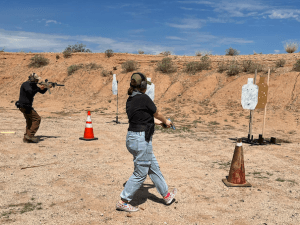
At night, it helps to place two glow-sticks on the ground, 2 or 3 meters in front of the Hostage, to designate the location of the doorway. Or you can use PVC pipe in the shape of a doorway.
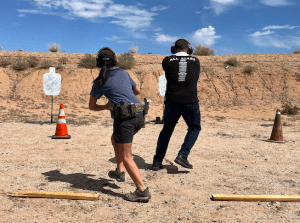
Most rooms in a home aren’t all that big (if a typical IPSC / USPSA match stage took place in your home, you might have to knock out some of the walls). Your “door” doesn’t need to be 20 meters up range. Five meters is plenty.
If your “hostage” is steel, it will be easy to tell if anybody hits the hostage. You will need to maintain more distance (about 10 meters) for safety. You’ll also need a range with side berms that will contain rounds that ricochet sideways off the steel, as any rounds striking the “hostage” (ideally none, but things happen in training) will be impacting at about a 45 degree angle.
Have an Instructor, RSO, or training partner call out which side Hostage is on, as Rescuer One enters the “room” through the “door.” Rescuer One goes that way on a forward oblique (strobing the flashlight if it’s dark). Rescuer Two heads on the other forward oblique and shoots the target behind the hostage target in the head.
Why in the head?
The head is a highly mobile target, armored (it deflects glancing blows), and only slightly larger than a softball. It’s hard to hit. But a centered brain shot is the ONLY way to unplug the operating system in near real-time.
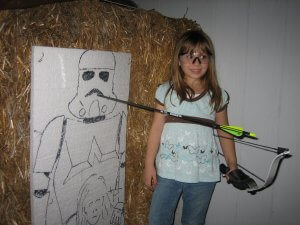
One legacy of all our square flat range training is, we want to shoot targets from directly in front of them. This training scar is so ingrained, I once saw a video of a bad guy walking along the side of a building, shooting at a line of cops parallel to the side of the building. One cop ran to get ahead of the bad guy–between the other cops’ guns and the bad guy’s gun–so he could shoot the bad guy from in front of him. You can’t make this stuff up.
This same training scar will tend to make your “Rescuers” move too close to the backstop so they can “face” the sideways facing Hostage Taker target. This will have them moving toward a shoot-through problem (being on opposite sides of the Hostage Taker target–see Uvalde below). Even if they don’t get very close to a crossfire, anything past a 90 degree L is too close to being on opposite sides of the target with live ammo. Plus, we don’t want the rounds going into the backstop at less than a 45 degree angle.
If you need to, toss down another glow stick a few feet in front of the Hostage target to mark the forward limit of advance. In daylight, you can use traffic cones.
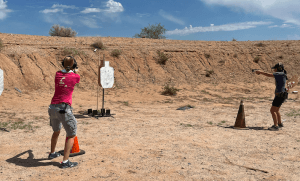
Never do this unless you have someone watching each Rescuer to make sure they don’t move too far forward. Have a pre-planned word that everybody knows means “Take your finger off the trigger and stop moving till the scenario is reset.”
I prefer “STOP!” over “CEASE FIRE!” because “fire” is part of “cease fire.” The pilots of a 747 at Tenerife only heard “OK” instead of the whole transmission, which was “OK, hold up” or some such; they wound up flying into the reason the controller wanted them to wait–another 747 turning mid runway in the fog. One corollary of Murphy’s Law states that any communication which CAN be misunderstood, WILL be misunderstood.
About That Wrist Snatch
Ever shoot at the head zone of a paper target and pull the shot down into the neck?
“That’s not so bad,” you think. “Not exactly where I wanted to put it, but if he’s got a hole in his trachea, that ought to take some wind out of his sails.”
Which is very true. The neck will probably do it. IF he’s not behind a hostage. If he is, and the bad guy’s neck is behind the hostage’s shoulder, with her subclavian / brachial arteries, that’s a no-go.
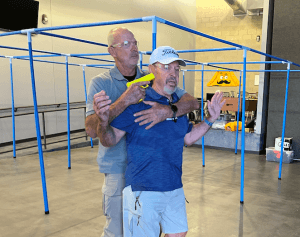
One absolute requirement in hostage rescue is you need to be able to put your rounds where you want ’em to go.
Every single time.
Low shots are caused by too much live fire. Lemmie ‘splain.
It may be that in this era of expensive ammo, you cannot live-fire practice too much. Rather, you can live fire too much in proportion to your dry practice.
Everybody develops anticipation of recoil after they shoot real ammo enough. Your hand gets flipped back and up by the recoil, so you subconsciously push your hand forward and down to counter. Unfortunately, that usually happens in the split-second before the shot goes off, so the bullets hit low. The shot placement on the target doesn’t lie.
More dry practice is the recommended medicine.
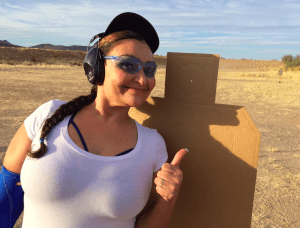
But dry practice can be very, very dangerous if certain precautions are not observed. It’s not just taking the magazine out, and clearing the chamber. YOU MUST DRY PRACTICE AT A BACKSTOP THAT WILL STOP AND ABSORB AN ERRANT BULLET SHOULD YOUR “DRY” PRACTICE TURN OUT TO BE NOT SO DRY.
Since missing is not an option, you must practice, and then practice some more. Because,
Amateurs practice till they get it right.
Professionals practice till they can’t get it wrong.
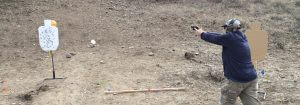
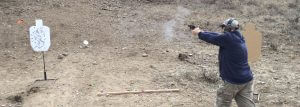
A balloon behind a steel target leaves zero doubt whether or not you hit the hostage taker’s head without snatching your wrist down and hitting the hostage in the shoulder. Downside, unless you are shooting frangible ammo, you shouldn’t even shoot near steel at less than 10 meters.
ARs in Hostage Rescue
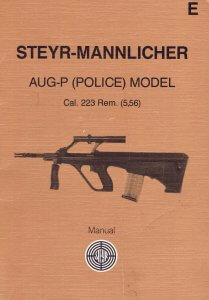
Outside the home, where the distances may be greater, rifles are the tools of choice. They provide a steadier aim, more power (= fewer shots to stop the bad guy), and may even have magnified optics.
When I was issued a US Customs AUG-P, I took a Patrol Rifle course taught by Giles Stock. He told us of a hostage taker in a bus station in the Pacific Northwest. As I recall the story, a guy had a knife to a woman’s throat. Two cops responded. One had an AR patrol rifle. The bad guy announced that he would kill her. The cops asked him for clarification. “I’m sorry; did you say you’re going to kill her?”
“Damn right I’m gonna kill he–” but he never finished the sentence. A single .223 bullet from the AR, flying over the hostage’s shoulder, did the job. Investigators found no fragments of the bullet in the wall behind where the hostage taker was standing.
At closer distances, ARs (even SBRs) have some distinct DISadvantages:
- One is that they don’t “bend around the hostage” one handed, as well as a handgun.
- There is more of an AR sticking out there for a bad guy to off-line in close quarters.
- The sight line of an AR (or a scoped rifle) is about two and a half inches above the bore line.
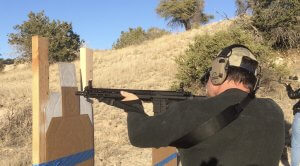
The bullet will be below the line of sight from the muzzle to the initial intersection, where the bullets arced trajectory rises up through the sight line, and then rises above it for a while, before dropping down through it at the actual zero distance.
With a military zero at 25 meters, there won’t be much of a difference at 20, but you will need significant “holdover” at 5 or 7 meters. In other words, if you want to hit him between the eyes, you might need to aim at his hairline. This is not a problem as long as you practice holdover at various distances until it becomes second nature.
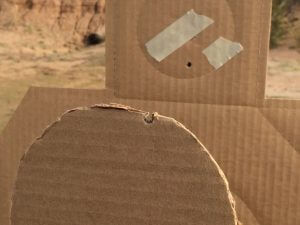
If you forget your holdover while you are shooting over a hostage’s shoulder, it could end up in the hostage’s subclavian artery before hitting your bad guy.
Uvalde
Active Shooters and Barricaded Suspects are beyond the scope of this article. There were many, many mistakes made at Robb Elementary, by the leadership, by the responders, by the teachers and administrators. There are only a few that are relevant to this discussion.
Some background for those of you who haven’t read the reports:
- The killer crashed his truck and started shooting a loud rifle at employees of a funeral home some distance (about a hundred yards) from the school at 11:28 am.
- Coach Yvette Silva was outdoors, heard the shooting, and saw the shooter jump the school fence (I went there; it’s about shoulder-high to me, and I’m short). There was no barbed wire; “we don’t want kids to feel they’re in a prison” is the tired old argument for not having physical safeguards which will at least slow down a killer. Coach Silva immediately notified the school via radio and ushered some third graders inside. According to one eye witness that I spoke with, the killer WALKED, he did not run, to the school. That gave the people in the school plenty of time to bunker down. But the school employees failed to lock any of the three outside doors to the building the killer attacked (the West building).
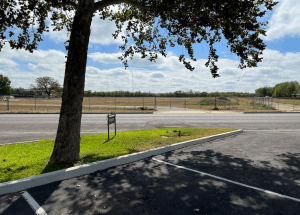
- At 11:33, five minutes after the crash and the first shots, the killer entered the building through the unlocked west door (the upper left end of a T-shaped pair of hallways). The killer MUST have had inside information that the door to room 111 did not lock, because he walked past the doors to classrooms 132, 131, and 116, proceeding DIRECTLY to the vestibule that had doors to classrooms 111 and 112. The classroom teacher in 111, Arnulfo Reyes, testified that he knew the door was broken and would not lock, and said he did not recall getting any lockdown alert, although other teachers in the school did.
- The bad guy entered room 111 and fired over 100 rounds over two and a half minutes, killing and wounding many in room 111 and the adjacent 112. Those kids were shot before the first law enforcement officers entered the building. One of the bullets went through walls and struck Mrs Avila, a teacher in room 109.
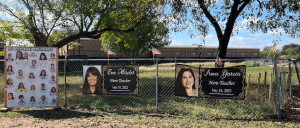
- The killer then bunkered down in a corner closet, aimed his gun at the door, and waited to ambush responding officers when they came through the door.
- Officers moved quickly to room 111, but as they reached for the knob, they took fire through the door.
- The officers backed off.
At this point, there were officers at the south end and the north end of the hall that had the doors to rooms 111 and 112. They remained there for about an hour.

Which leads us to the first take-away, relevant to this discussion of hostage takers in your home.
What would the teams at each end of the hallway have done if the bad guy had come out shooting?
The presence of the other team at the opposite end of the hallway would have precluded anyone with any sense from firing at him. If they had, they would have shot each other with cross-fire.
What if you hear the commotion, run and get your gun, and accost the killer holding your daughter hostage in the hallway–only to have other concerned family members appear in the same hallway, on the opposite side from the kidnapper?
That could be good or bad, but many of the potentialities are bad. On the plus side, the ones behind the hostage taker could sneak up behind him while you distract him. An upward angled shot to the back of his head MIGHT have minimal risk to the hostage (or the rescuer in front of him). But if the hostage taker does know they are there, your chances of getting a clear shot on the hostage taker are much lower if there are other good guys in the hallway behind him. There are some niche techniques we can teach you for taking down bad guys in long narrow spaces–such as upward angled shots and in quartata–but even they are fraught with risk for those on the other end of the hall.
At Uvalde, any leader with a modicum of tactical acumen would have sent one of the teams somewhere, anywhere, else–ideally the south end team, because the team at the north end of the hallway had the east-west hallway for staging (they set up a casualty collection point in the east side of the north hallway). But which team would have left wasn’t nearly as important as that one of them should have. Neither did.
For your purposes in hostage rescue, an L is a capital L, not a lower case l. You can’t be on opposite sides of your hostage taker. He must be in something approximating a 90 degree angle between you two.
The man who was supposed to be in charge could have sent the south team around the east side of the building to try to dominate the room from the outside (or at least gather intel) through a window. But he did not, for several reasons:
- He clearly lacked tactical acumen.
- The first aspect of tactical acumen he should have possessed was the knowledge that someone must take charge in these situations.
- He had signed off on a policy stating that he was supposed to be in charge. That should have meant establishing the ICS, Incident Command System, and running the show, probably from outside the building.
- Because his knowledge and training had not kept up with the times, he apparently thought he was dealing with an old-fashioned barricaded suspect.
It had, in fact, turned into a barricaded suspect situation, but with a major difference from when the old “sweat and starve him out” tactics for barricaded suspects with LIVE, UNINJURED hostages were developed. The suspect did not have hostages, per se. He had dead and dying victims. When a robbery goes bad and a suspect barricades himself with hostages, his goal is a negotiated escape. The killer at Uvalde had a different goal: to maximize carnage. The longer it went on, the more of the kids he had shot bled out and died.
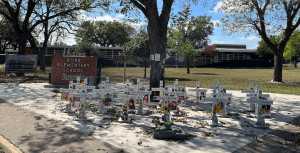
His only remaining wish in life was to kill as many cops as he could before he went down. Any wounded “hostages” still living were not hostages to him.
They were bait.
But the police weren’t biting. He had sprung his trap just a bit too soon to catch them in the fatal funnel of the doorway, and they had backed off.
Because the guy who was supposed to be in charge wasn’t making many decision, every once in a while over the next hour the killer would fire a few shots, so they would view him as an “active” killer and come into the KZ (kill zone) of his ambush.
To their credit, the officers on scene did start evacuating the other classrooms through outside windows during the 70+ minutes they had the bad guy contained in room 111.
I spoke with someone who is very high up in the Border Patrol about Uvalde. He was privy to more info than I am (I’m basing most of this on the report by the Texas House of Representatives, as well as the ALERRT report, and my interview of an eyewitness who worked at the funeral home). My BP connection believes the killer was shooting through walls at the sounds of people he heard in adjacent rooms. In that respect, the killer was still “active.” When a killer is actively assaulting people, the national best practice since Columbine has been, and remains, to run pell-mell to the sound of the guns.
Which brings up my second point, as the Robb Elementary tragedy relates to the main themes of this article.
In hostage situations, just as Miyamoto Musashi said about fighting multiple threats,
Waiting is bad.
What used to be the standard practice for hostage situations, bore him to death and starve him out, is now often outmoded. Every second you delay increases both the killing and the dying (at Robb Elementary, the killing was mostly done before the cops arrived; it’s likely that several of the wounded died over the next hour since they were unable to get timely medical treatment).
This is why I say that if you are armed, responsible, and competent, you should take the shot on a hostage taker as soon as you can get a clear shot.
Having an armed friend who is also well trained on V to L tactics and a competent shot vastly increases your opportunity to get that clear shot.
Disclaimer about Uvalde
I have been through a few doors. And I have some knowledge of (and experience with) small unit tactics.
But I did not visit Robb Elementary in Uvalde until well AFTER the incident. Take anything anybody who wasn’t there when it was happening, including me, tells you about Robb Elementary with a grain of salt.
Nothing in this article is intended to second guess the actions (or inactions) of brave responders who were trying their level best to make a horrible situation less awful (even if some of them thought the smartest thing was to do nothing and wait him out), under tremendous pressure, without the benefit of 20 / 20 hindsight. Refer to Norm the Navigator for more about talking smack when one’s opinion is unqualified. It chaps my behind when I hear talking head reporters (or politicians) who have never put their life on the line for anybody talking about what the cops could or should have done.
I had some issues with the way the Border Patrol did business when I worked for that agency, but I have rarely been so proud to be a former BPA as when I learned that the ones who finally broke the deadlock, who saddled up and did a direct frontal assault right through that door (one of whom has a nice scar on his head to show for it) and took out the killer in Robb Elementary, were Patrulla Fronteriza.
De los Estados Unidos.
–George H, lead instructor, Heloderm LLC
Some parts of this article were excepted from the password protected Training Summary for Manage Your X, a pair of classes Greg G and I taught on 15 Sep 2023 at the Arizona Church Security Network’s 5th annual Defending the Flock conference. Some of these tips and tricks were originally published in a password protected AAR for a Firearms Instructor class on 19 Dec 2020.
